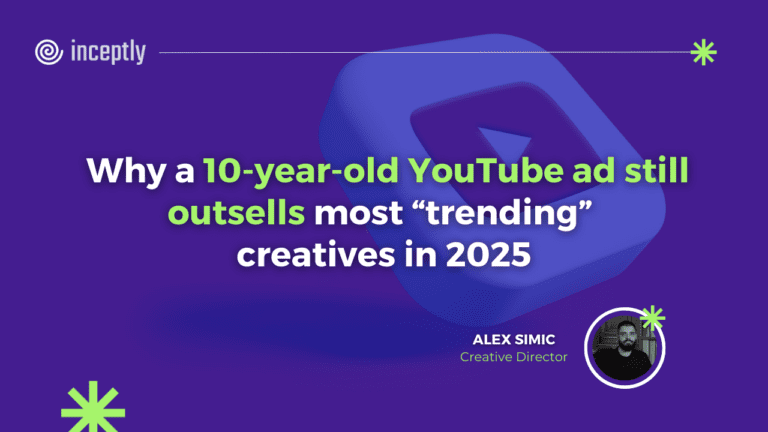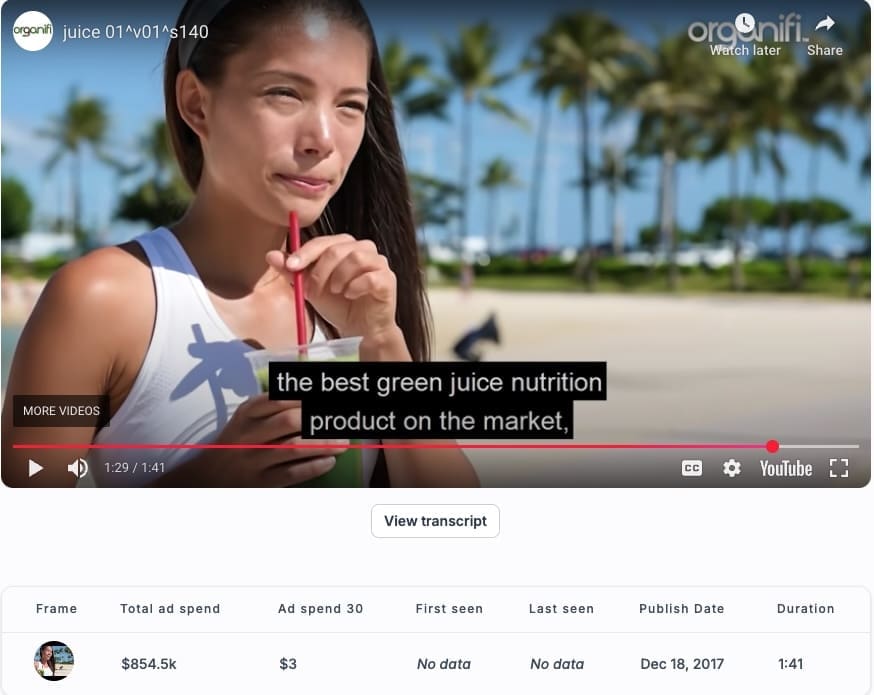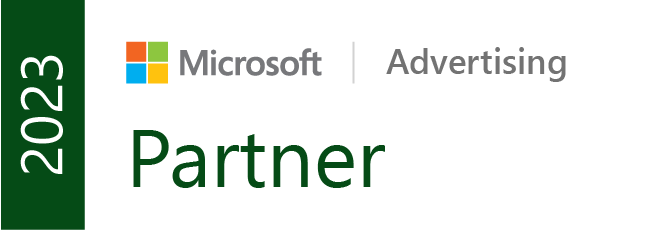
If we’re being real with ourselves, us, advertisers, marketers, business owners are often pretty much obsessed with finding the new trend, predicting what will be the next big thing, but in reality, all of those are often created by taking a good look at what advertising and copywriting are really about.
We’re diving into an ad that’s become a bit of a legend in the YouTube advertising world – the Organifi Green Juice ad featuring Drew Canole. This one has been inspiring copywriters and marketers for years, and for good reason.
Let’s break it down and see why it’s still relevant in 2025 and how it might be relevant for you.
Want to brainstorm with our team on new ways to scale your business with YouTube Ads (and other performance video platforms)?
Join us for a free YouTube ad brainstorming session👇
This ad has it all: Hook, proof, authority, and zero B.S.
First off, the hook:
“Every morning, I take one scoop of Organifi green juice, mix it up in a glass of water, and, congratulations, you just had 11 of the world’s healthiest superfoods in seven seconds of work.”
Boom. Value proposition, simplicity, and benefits all rolled into one. That’s how you grab attention in those crucial first seconds we all constantly yap about.
That is the obvious first step, but what else?
1. Demonstration in action
Remember how we’ve been repeatedly mentioning showing, not telling? Sometimes I’m boring myself with the same examples, but look at it like this – yes, it’s the same principles, but all of these are showing you different ways in which you can implement them.
This ad nails it, too. Drew’s not just talking about the product; he’s showing you exactly how to use it. It’s simple, it’s visual, and it makes the whole process seem effortless. This kind of demonstration is gold in product ads, especially for something like a health supplement.
2. Benefit ‘bombardment’
They’re hitting you with specific benefits for each ingredient. Spirulina for weight loss, ashwagandha for stress reduction and better skin, matcha for energy. It’s like a rapid-fire list of “here’s why you need this in your life.” This approach works because it gives viewers multiple reasons to be interested, increasing the chances of hitting on something that resonates with them personally.
3. Authority building
Drew introduces himself as the founder and CEO right off the bat. Not just some random spokesperson; it’s the guy who created the product. In an age where authenticity is key, having the founder speak directly to the audience is a powerful move.
4. Objection handling
“Unlike a lot of those other green juices, this stuff actually tastes amazing.”
They’re tackling a common objection head-on. This is crucial in 2025, when consumers are more skeptical than ever. By addressing potential concerns upfront, they’re building trust and removing barriers to purchase.
5. The power of comparison
“Just one ounce is equivalent to eating 23 pounds of ordinary garden vegetables.”
That’s the kind of stat that makes you sit up and take notice. It’s specific, it’s impressive, and it’s easy to remember. This comparison technique is incredibly effective for helping viewers grasp the value of the product quickly.
Why mastering the basics still beats AI hype
This ad is still relevant because it nails the fundamentals of direct-response advertising. It’s clear, it’s benefit-driven, it addresses objections, and it makes taking action seem like a no-brainer. In a world where we’re always chasing the next big thing in advertising, this ad reminds us that sometimes, the classics should be revisited, as you can absolutely always dig out something new.
But here’s what you might not have noticed:
1. The seven-second promise
They keep hammering home how quick and easy it is. “Seven seconds of work” is repeated multiple times. In 2025, when attention spans are shorter than ever, emphasizing speed and simplicity is crucial.
2. Certification stacking
USDA organic, gluten-free, soy-free, dairy-free, vegan. They’re not just selling a product; they’re selling a lifestyle choice. This appeals to a wide range of health-conscious consumers and positions the product as premium and trustworthy.
3. The language of transformation
Notice how they talk about “forcing your body to shed weight” and “leaving you with that skin and hair that maybe you once had when you were a 20-year-old.”? They’re not just selling health; they’re selling transformation. This taps into deeper emotional desires beyond just physical health.
The big takeaway? In 2025, when we’re all chasing the latest AI-driven, hyper-personalized advertising techniques, this ad reminds us that the fundamentals still matter. Clear benefits, strong visuals, authority building, and addressing objections never go out of style.
Old-school principles, modern results: How to build better ads
Here’s the thing, though – while this ad is a classic, it doesn’t mean you should just copy it blindly. The key is to understand the principles at work here and apply them to your unique product or service.
Think about it:
What’s your “seven-second promise”? How can you make your offer seem irresistibly simple and quick?
What objections do your potential customers have, and how can you address them head-on in your ad?
How can you demonstrate your product in a way that’s visually engaging and immediately shows its value?
What’s your equivalent of “23 pounds of vegetables in one ounce”? What impressive comparison can you make that’ll stick in viewers’ minds?
Remember, in 2025, viewers are more sophisticated than ever. They can smell BS from a mile away. That’s why authenticity, like having the founder speak directly to the camera, is so powerful. It’s not just about what you say but how you say it.
And let’s not forget about the power of repetition. Notice how they keep hammering home key points like the “seven seconds” and the number of superfoods? In a world of information overload, repetition helps your message stick.
The bottom line is this: While the platforms and technologies we use for advertising are constantly evolving, the core principles of what makes an ad effective remain surprisingly constant. It’s all about understanding your audience, clearly communicating your value proposition, and making it easy for viewers to take the next step.
So, next time you’re crafting a product ad, take a page from Organifi’s book. Focus on clear benefits, demonstrate the product, build credibility, and make it easy for viewers to see themselves using and benefiting from what you’re selling. And remember, sometimes the simplest approach is the most effective.
Now, if you’ll excuse me, I suddenly have a craving for some green juice. And hey, if you’re looking to create ads that stand the test of time like this one, you know where to find us. We’re always pumped to help businesses craft YouTube ads that don’t just get views but also drive real results.
Want to brainstorm with our team on new ways to scale your business with YouTube Ads (and other performance video platforms)?
Join us for a free YouTube ad brainstorming session:
Want more content like this?
Don’t miss out on the latest news and updates from the world of Direct Response advertising! Subscribe to our newsletter today 👇

Alex Simic, Creative Director
Alex Simic is the person responsible for all creative work that stands behind Inceptly since stepping into his role in 2022. He comes from the role of the Media Buying Team Lead and Strategist behind some of Inceptly’s biggest successes. He has collaborated with the biggest names in the Direct Response industry, whether as a Senior Account Manager & Media Buyer or Creative Director. His main goal is bridging the gap between Media Buying and Creative, ensuring that the videos Inceptly produces are data-based and giving our clients the best chance at achieving success.
Like this post? Let's continue the conversation!
Get in touch with us by shooting us a quick email or tagging us on LinkedIn or Instagram, and sharing your thoughts. Your feedback helps us keep our blog relevant and interesting.
Get Our Newsletter
Need Help?
Get in touch with us for an insightful evaluation of your ads + actionable tips to help amp up your direct response revenue




